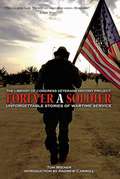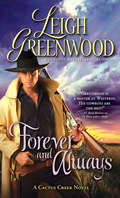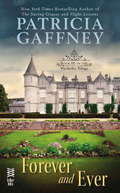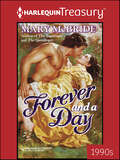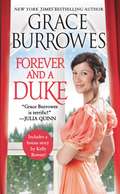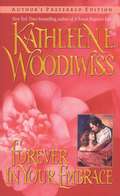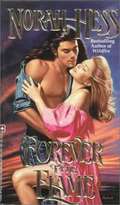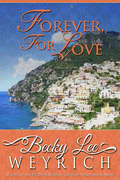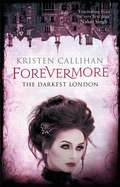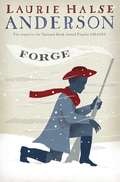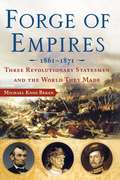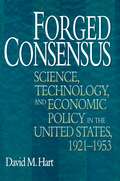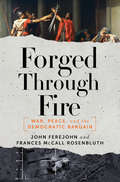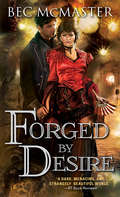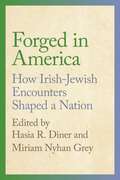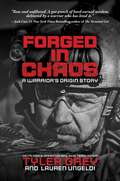- Table View
- List View
Forever a Lord
by Delilah MarvelleLady Imogene Norwood lives a sheltered life of quiet respectability and routine...until she meets the wild and broken Lord Atwood. He is wholly unexpected among London's elite, and the very shy English rose suddenly realizes that a little chaos might just be what her heart desires.Lord Nathaniel James Atwood doesn't believe true love exists. Since scandal tore him away from his family at an early age, he has spent his life fighting for what he wants. That attitude has made him a rising star in bare-knuckle boxing, and now leads him back to London to reclaim the life that was stolen from him. But upon meeting the innocent Imogene, his beliefs are trounced...as guarding his heart against her proves to be the fight of his life.
Forever a Soldier: Unforgettable Stories of Wartime Service
by Tom WienerForever a Soldier captures the personal side of war in 37 extraordinary narratives that bear eloquent witness to both the life-changing experience of battle and to the unflagging spirit that sustained countless ordinary Americans plunged into the bloody conflicts of the deadliest, most destructive century in human history. Culled from letters, diaries, private memoirs, and oral histories collected by the Library of Congress Veterans History Project, their stories paint an unforgettable group portrait of our country's armed forces. <P><P>Some tell of frontline action: a doughboy's 1918 baptism of fire: a battleship gunner's grim duel with Japanese planes; a female fighter pilot's capture by Iraqis during the Gulf War. Others evoke moments of relief and reflection, or recall deeply moving episodes: two wounded soldiers—one German, one American—clasping hands in the wordless brotherhood of pain; a POW whose faith gave him the strength to endure torture in the notorious "Hanoi Hilton;" a GI's lifelong grief for a buddy killed on the last day of World War II in Europe. <P><P>Forever a Soldier presents famous incidents like the sinking of the USS Indianapolis and her survivors' terrifying ordeal in the shark-infested Pacific, and heroic figures like John McCain, but it's the long-untold stories of unheralded patriots that best reveal the universal truths of war: courage and fear, horror and exhilaration, sorrow and triumph—the shared legacy of every American veteran, and a debt of honor the rest of us must respect but can never repay.
Forever and Always
by Leigh GreenwoodFrom USA Today Bestselling Author Leigh Greenwood comes a historical Western romance filled with gritty cowboy heroes, strong-willed heroines, and a whole lot of heart in the Wild West.HE KNOWS SHE CAN NEVER BE HIS...Logan Holstock, oldest of three brothers orphaned on the Santa Fe Trail, has always been content knowing his brothers were alive and happy somewhere in the vast and brutal West-until he learns he may be dying. Certain he has little time left, Logan sets out to find them and end his days near a family he's never known...and stumbles across a strong yet vulnerable widow who makes him yearn for what can never be his.Logan knows he shouldn't love Sibyl Spencer-he couldn't bear leaving her a widow all over again. But as he finds himself drawn deeper into the lives of this small Western town, he can't escape the longing to find peace in her arms. When he discovers that his death sentence is anything but, Logan swears he will do whatever it takes to prove himself to the woman he loves...and show he believes their love is worth fighting for.Cactus Creek Cowboys: To Have and to Hold (Book 1) To Love and to Cherish (Book 2)Forever and Always (Book 3)Praise for Bestselling Historical Western Romances by Leigh Greenwood: "Leigh Greenwood has once again proven he can write a compelling and romantic Western."-Fresh Fiction "This is a solid, enjoyable western from a veteran storyteller."-RT Book Reviews"Greenwood's books are bound to become classics."-Rendezvous
Forever and Ever
by Patricia GaffneyFrom the New York Timesbestselling author of The Saving Gracesand Flight Lessons-a simply glorious Victorian novel now reissued in a beautiful trade edition.
Forever and Ever: (Intermix)
by Patricia GaffneyFrom the New York Times bestselling author of The Saving Graces and Flight Lessons comes Book III of the Wyckerley Trilogy...Forever and Ever Sophie Deene is every bit her father's daughter--proud, fiercely independent...yet bound by the constraints of convention. When she takes over her father's copper mine upon his death and finds herself wildly attracted to the handsome, insolent Cornishman she has hired as foreman, she refuses to risk everything for an unsuitable marriage...Embittered by past tragedy and burdened by dark secrets, Connor Pendarvis lives only to destroy the belle of Wyckerley. But even as he begins to tear apart Sophie's world, Connor finds himself falling in love with her... and fighting a passion that promises to engulf them both forever and ever...
Forever and a Day
by Delilah MarvelleRoderick Gideon Tremayne, the recently appointed Duke of Wentworth, never expected to find himself in New York City, tracking down a mysterious map important to his late mother. And he certainly never expected to be injured, only to wake up with no memory of who he is. But when he sees the fiery-haired beauty who's taken it upon herself to rescue him, suddenly his memory is the last thing on his mind. Georgia Milton, the young head of New York's notorious Forty Thieves, feels responsible for the man who was trying to save her bag from a thief. But she's not prepared for the fierce passion he ignites within her. When his memory begins to return, her whole world is threatened, and Roderick must choose between the life he forgot and the life he never knew existed....
Forever and a Day
by Mary McBrideGideon SummerfieldBank robber. Prisoner. Let out of jail only on the condition that he capture his cousin. Well, it might take a thief to catch a thief, but Gideon didn't plan on being caught himself-at least not by a bright-eyed female full of vinegar...and honey. Sweet, warm honey.Honey LoganBanker's daughter. Pampered debutante. Now a woman determined to abandon everything for a life with the outlaw who'd robbed her father's bank. She'd cuffed herself to him before she could think, before she'd looking into his eyes and known that she'd lost the key forever.
Forever and a Duke: Includes A Bonus Novella (Rogues to Riches #3)
by Grace Burrowes'Grace Burrowes is terrific!' Julia Quinn'Grace Burrowes is a romance treasure' Tessa DareA duke meets his match in the last place he'd ever expect in this charming Regency romance by the New York Times bestselling author of My One and Only Duke.Wrexham, Duke of Elsmore, is overrun by family obligations. With three sisters to escort about Town and aunties who insist he dance with every eligible young woman, he barely has time to manage his dukedom. When he finally carves out a moment to evaluate his family's finances, he learns that he - and his sisters - are on the verge of social catastrophe.Eleanora Hatfield has an uncanny knack for numbers, but she knows from experience that dealing with the peerage can only lead to problems. Though she wants nothing to do with any titled gentleman, she reluctantly agrees to help when Rex seeks aid from her employer. What starts out as an unwanted assignment soon leads to forbidden kisses and impossible longings. But with scandal haunting Ellie's past and looming in Rex's future, how can true love lead to anything but heartbreak?A Rogues to Riches bookPraise for Grace Burrowes:'Smart, sexy, and oh-so romantic' Mary Balogh'Wonderfully funny, moving romance, not to be missed!' Eloisa James'If you're not reading Grace Burrowes you're missing the very best in today's Regency Romance!' Elizabeth Hoyt'Burrowes is a writer of towering talent' USA Today Happy Ever After
Forever and a Duke: Includes a bonus novella (Rogues to Riches #3)
by Grace BurrowesA duke meets his match in the last place he'd ever expect in this charming Regency romance.Wrexham, Duke of Elsmore, is overrun by family obligations. With three sisters to escort about Town, a legion of cousins to look after, and aunties who insist he dance with every eligible young woman, he barely has time to manage his dukedom. When he finally carves out a moment to evaluate his family's finances, he learns that he -- and his sisters -- are on the verge of social catastrophe. Eleanora Hatfield has an uncanny knack for numbers, but she knows from experience that dealing with the peerage can only lead to problems. Though she wants nothing to do with any titled gentleman, she reluctantly agrees to help when Rex seeks aid from her employer. What starts out as an unwanted assignment soon leads to forbidden kisses and impossible longings. But with scandal haunting Ellie's past and looming in Rex's future, how can true love lead to anything but heartbreak? Includes the bonus story "The Lady in Red" by Kelly Bowen!
Forever in My Heart (The Dennehy Sisters Series #3)
by Jo GoodmanInjured and lost, Mary Margaret "Maggie" Dennehy stumbles into a seedy New York City neighborhood. When the New York heiress awakes in her fashionable 5th Avenue residence, she remembers nothing of her experience, save a haunting dream that fills her with longing.Colorado Rancher Connor Holiday can't forget the passion filled night spent in the fancy New York bordello, or the exquisite lover who so willingly played the innocent. But when that lover turns out to be the bastard daughter of one of the city's richest men, he is forced to choose between what he wants and what he needs.To save his ranch... to save her dreams... Connor and Maggie strike a bargain where the success of their marriage hinges on breaking their vows.REVIEWS:"Jo Goodman is a master at historical romance." ~Fresh FictionTHE DENNEHY SISTERS SERIES, in series order:Only My LoveMy Heart's DesireForever in My HeartAlways in My DreamsOnly in My ArmsTHE MARSHALL BROTHERS SERIES in order:Her Defiant HeartHis Heart's RevengeTHE THORNE BROTHERS TRILOGY, in series order:My Steadfast HeartMy Reckless HeartWith All My Heart
Forever in Texas
by Jodi ThomasFrom the New York Times bestselling author of the Harmony McLain and Whispering Moutain series'. Sanford Colston left his hometown of Saints Roost to hire its school a new teacher--but instead found himself stuck at the Dallas train station, robbed of the clothes off his back. It was clear to Ford that this thief wasn't your ordinary outlaw--and he was right. Hannah was a beautiful woman on the run, desperate for a disguise that would help her escape her dangerous past. But when fate forced their paths to cross again, Ford couldn't let Hannah get away twice. Ford wanted to help his charming young bandit, but didn't know how--until she had a most exciting idea. Hannah could hide in Saints Roost. Back in the strict little town, Hannah made quite a first impression...and, with Ford at her side, learned that sometimes life offers second chances...
Forever in Your Embrace
by Kathleen E. WoodiwissOn a dark and dangerous road, a daring British adventurer saves the life of a countess of royal blood. In all his travels, Colonel Tyrone Rycroft has never encountered a woman as breathtaking, alluring, and inscrutably mysterious as the bewitching Synnovea. But his selfless bravery has drawn him into peril -- and into an inescapable web of intrigue and seduction. In an opulent and treacherous imperial court, the proud, headstrong lady's dashing champion has become a pawn in a dangerous game of power and influence -- and only his great courage and wits will enable him to survive it. But Rycroft's enflamed desire will not let him escape to the safety of his own world -- not until his dream is realized, and the enigmatic, highborn beauty has given herself to him freely, honestly, and forever.
Forever, For Love
by Becky Lee WeyrichA woman’s mysterious past leads her from Texas to Europe in this “spellbinding, deliciously sensuous read” from the award-winning author (Rendezvous). Orphaned as a child, Pandora Sherwood grows to be wild, fierce, and independent—the scandal of Galveston society. Her rebellious spirit, however, appeals to one man: Ward Gabriel, a self-made adventurer who vows to have her as his own. But the visions that haunt Pandora’s dreams compel her to seek out the answers to the questions of her restless soul. She flees to Europe and gains fame through her art, but along her journey of self-discovery her heart remains in Galveston with Ward. Yearning to return to the man she loves, Pandora must unveil the mystery of her dreams and the secret that tore her from her home—and from Ward’s embrace. “One of the finest and most gifted writers. A master storyteller!” —Romantic Times
Forevermore (Darkest London #7)
by Kristen CallihanIsolated and alone, Sin Evernight is one of the most powerful supernatural creatures in heaven and on earth. As an angel of vengeance, he hunts down the darkest evil, but when his long-lost friend, Layla Starling, needs him, he vows to become her protector. Even though she will be horrified by the man he has become. Now a famous singer and the toast of London, Layla believes that Sin is only here to guard her from rabid fans and ardent suitors. However, the truth is far more sinister. Desperate to avoid losing Layla a second time, Sin will face a test of all his powers to defeat an unstoppable foe - and win an eternity with the woman he loves.
Forevermore (Darkest London #8)
by Kristen CallihanThe final book in USA Today bestselling author Kristen Callihan's dark, atmospheric series set in Victorian London will appeal to fans of Amanda Quick.Miss Layla Starling, the young, beautiful, and extremely wealthy heiress, is the talk of London. Until now, she's managed to evade the marriage noose. Despite the fact that she is unfortunately American, she's received a staggering number of offers. And turned down every one. St. John Evernight does not want to admit the relief he feels every time he hears that she has rejected one of her suitors. Which is unfair of him. Layla deserves to be happy. But he can not offer her happiness. He will never be normal, never be anything but a freak in her world. So St. John resolves to keep his distance, until he is recruited by the Society for the Suppression of Supernaturals to guard Layla. For she is in grave danger, and he is about to learn the full extent of his powers.'Callihan has a great talent for sexual tension and jaw-dropping plots' - Diana Gabaldon'A sizzling paranormal with dark history and explosive magic! Callihan is an impressive new talent.' - Larissa Ione'Fascinating from the very first page' - Nalini Singh
Forge (The Seeds of America Trilogy #2)
by Laurie Halse Anderson&“One of the best novels they have ever read.&” —Kirkus Reviews Curzon navigates the dangers of being a runaway slave in this keenly felt second novel in in the historical middle grade The Seeds of America trilogy from acclaimed author Laurie Halse Anderson.Blistering winds. Bitter cold. And the hope of a new future. The Patriot Army was shaped and strengthened by the desperate circumstances of the Valley Forge winter. This is where Curzon the boy becomes Curzon the young man. In addition to the hardships of soldiering, he lives with the fear of discovery, for he is an escaped slave passing for free. And then there is Isabel, who is also at Valley Forge—against her will. She and Curzon have to sort out the tangled threads of their friendship while figuring out what stands between the two of them and true freedom.
Forge of Empires: Three Revolutionary Statesmen and the World They Made, 1861-1871
by Michael Knox BeranIn the space of a single decade, three leaders liberated tens of millions of souls, remade their own vast countries, and altered forever the forms of national power: Abraham Lincoln freed a subjugated race and transformed the American Republic. Tsar Alexander II broke the chains of the serfs and brought the rule of law to Russia. Otto von Bismarck threw over the petty Teutonic princes, defeated the House of Austria and the last of the imperial Napoleons, and united the German nation. The three statesmen forged the empires that would dominate the twentieth century through two world wars, the Cold War, and beyond. Each of the three was a revolutionary, yet each consolidated a nation that differed profoundly from the others in its conceptions of liberty, power, and human destiny. Michael Knox Beran's Forge of Empires brilliantly entwines the stories of the three epochal transformations and their fateful legacies. Telling the stories from the point of view of those who participated in the momentous events -- among them Walt Whitman and Friedrich Nietzsche, Mary Chesnut and Leo Tolstoy, Napoleon III and the Empress Eugénie -- Beran weaves a rich tapestry of high drama and human pathos. Great events often turned on the decisions of a few lone souls, and each of the three statesmen faced moments of painful doubt or denial as well as significant decisions that would redefine their nations. With its vivid narrative and memorable portraiture, Forge of Empires sheds new light on a question of perennial importance: How are free states made, and how are they unmade? In the same decade that saw freedom's victories, one of the trinity of liberators revealed himself as an enemy to the free state, and another lost heart. What Lincoln called the "germ" of freedom, which was "to grow and expand into the universal liberty of mankind," came close to being annihilated in a world crisis that pitted the free state against new philosophies of terror and coercion. Forge of Empires is a masterly story of one of history's most significant decades.
Forge of Empires: Three Revolutionary Statesmen and the World They Made, 1861-1871
by Michael Knox BeranIn the space of a single decade, three leaders liberated tens of millions of souls, remade their own vast countries, and altered forever the forms of national power: Abraham Lincoln freed a subjugated race and transformed the American Republic. Tsar Alexander II broke the chains of the serfs and brought the rule of law to Russia. Otto von Bismarck threw over the petty Teutonic princes, defeated the House of Austria and the last of the imperial Napoleons, and united the German nation. The three statesmen forged the empires that would dominate the twentieth century through two world wars, the Cold War, and beyond. Each of the three was a revolutionary, yet each consolidated a nation that differed profoundly from the others in its conceptions of liberty, power, and human destiny. Michael Knox Beran's Forge of Empires brilliantly entwines the stories of the three epochal transformations and their fateful legacies. Telling the stories from the point of view of those who participated in the momentous events -- among them Walt Whitman and Friedrich Nietzsche, Mary Chesnut and Leo Tolstoy, Napoleon III and the Empress EugÉnie -- Beran weaves a rich tapestry of high drama and human pathos. Great events often turned on the decisions of a few lone souls, and each of the three statesmen faced moments of painful doubt or denial as well as significant decisions that would redefine their nations. With its vivid narrative and memorable portraiture, Forge of Empires sheds new light on a question of perennial importance: How are free states made, and how are they unmade? In the same decade that saw freedom's victories, one of the trinity of liberators revealed himself as an enemy to the free state, and another lost heart. What Lincoln called the "germ" of freedom, which was "to grow and expand into the universal liberty of mankind," came close to being annihilated in a world crisis that pitted the free state against new philosophies of terror and coercion. Forge of Empires is a masterly story of one of history's most significant decades.
Forged By War: Australian Veterans in Combat and Back Home
by Gina LennoxIn Forged By War, Australian veterans and their families reveal the experience of combat and how it has changed their lives. These stark first-hand accounts describe the reality of military action and its personal consequences in every major conflict and peacemaking mission since World War II, including the invasion of Iraq. Sometimes the reader is in lockstep with a soldier on patrol, watching as a land mine explodes, or a local militiaman points an AK–47 at Australian peacemakers. Other times, the reader is inside a returned veteran's head, feeling their superfluous adrenalin, their need to control their environment, even at home. With accounts from Peter and Lynne Cosgrove, Graham Edwards, Frank Hunt (I Was Only Nineteen), other veterans of Vietnam, Glenda Humes (daughter of Capt Reginald Saunders), peacemakers and an SAS trooper, this compelling investigation by Gina Lennox in underpinned by the question: where does family fit in a soldier's life?
Forged Consensus: Science, Technology, and Economic Policy in the United States, 1921-1953 (Princeton Studies in American Politics: Historical, International, and Comparative Perspectives #109)
by David M. HartIn this thought-provoking book, David Hart challenges the creation myth of post--World War II federal science and technology policy. According to this myth, the postwar policy sprang full-blown from the mind of Vannevar Bush in the form of Science, the Endless Frontier (1945). Hart puts Bush's efforts in a larger historical and political context, demonstrating in the process that Bush was but one of many contributors to this complex policy and not necessarily the most successful one. Herbert Hoover, Karl Compton, Thurman Arnold, Henry Wallace, Robert Taft, and Curtis LeMay--along with more familiar figures like Bush--are among those whose endeavors he traces.Hart places these policy entrepreneurs in the broad scheme of American political development, connecting each one's vision of the state in this apparently esoteric policy area to the central issues, events, and figures of mid-century America and to key theoretical debates. Hart's work reveals the wide range of ideas, often in conflict with one another, that underlay what later observers interpreted as a "postwar consensus." In Hart's view, these visions--and the interests and institutions that shape their translation into public policy--form the enduring basis of American politics in this important area. Policymakers today are still grappling with the legacies of the forged consensus.
Forged Through Fire: War, Peace, and the Democratic Bargain
by Frances Mccall Rosenbluth John FerejohnPeace, many would agree, is a goal that democratic nations should strive to achieve. But is democracy, in fact, dependent on war to survive? Having spent their celebrated careers exploring this provocative question, John Ferejohn and Frances McCall Rosenbluth trace the surprising ways in which governments have mobilized armies since antiquity, discovering that our modern form of democracy not only evolved in a brutally competitive environment but also quickly disintegrated when the powerful elite no longer needed their citizenry to defend against existential threats.? Bringing to vivid life the major battles that shaped our current political landscape, the authors begin with the fierce warrior states of Athens and the Roman Republic. While these experiments in “mixed government” would serve as a basis for the bargain between politics and protection at the heart of modern democracy, Ferejohn and Rosenbluth brilliantly chronicle the generations of bloodshed that it would take for the world’s dominant states to hand over power to the people. In fact, for over a thousand years, even as medieval empires gave way to feudal Europe, the king still ruled. Not even the advancements of gunpowder—which decisively tipped the balance away from the cavalry-dominated militaries and in favor of mass armies—could threaten the reign of monarchs and “landed elites” of yore.? The incredibly wealthy, however, were not well equipped to handle the massive labor classes produced by industrialization. As we learn, the Napoleonic Wars stoked genuine, bottom-up nationalism and pulled splintered societies back together as “commoners” stepped up to fight for their freedom. Soon after, Hitler and Stalin perfectly illustrated the military limitations of dictatorships, a style of governance that might be effective for mobilizing an army but not for winning a world war. This was a lesson quickly heeded by the American military, who would begin to reinforce their ranks with minorities in exchange for greater civil liberties at home.? Like Francis Fukuyama and Jared Diamond’s most acclaimed works, Forged Through Fire concludes in the modern world, where the “tug of war” between the powerful and the powerless continues to play out in profound ways. Indeed, in the covert battlefields of today, drones have begun to erode the need for manpower, giving politicians even less incentive than before to listen to the demands of their constituency. With American democracy’s flanks now exposed, this urgent examination explores the conditions under which war has promoted one of the most cherished human inventions: a government of the people, by the people, for the people. The result promises to become one of the most important history books to emerge in our time.
Forged by Desire
by Bec Mcmaster"Edgy, dark, and shot through with a grim, gritty intensity, McMaster's latest title adds to her mesmerizing steampunk series with another gripping, inventive stunner."-Booklist, starred review for Heart of Iron A FEAR SHE CAN'T ESCAPETen years ago, Perry fled her thrall contract to find sanctuary among the Nighthawks. In that time, she's become a respected woman of the Guard, and she's wanted Garrett Reed for as long as she can remember. But when a new case takes a chillingly familiar turn, Perry finds herself once again in the path of a madman...only this time, there's nowhere left to run.A DESIRE THAT CAN'T BE TEMPERED Out of their depth and racing against time, Perry and Garrett must learn to trust the desire sparking between them...or risk losing themselves forever to the darkness stalking London's streets.
Forged in America: How Irish-Jewish Encounters Shaped a Nation (Goldstein-Goren Series in American Jewish History)
by Hasia R. Diner Miriam Nyhan GreyExamines how Irish and Jewish Americans defined their place in a complex society.The story of America is the story of the unlikely groups of immigrants brought together by their shared outsider status. Urban American life took much of its shape from the arrival of Irish and Jewish immigrants in the nineteenth and twentieth centuries, and Forged in America is the story of how Irish America and Jewish America collided, cooperated, and collaborated in the cities where they made their homes, all the while shaping American identity and nationhood as we know it.Bringing together leading scholars in their fields, this volume sheds light on the underexplored histories of Irish and Jewish collaboration. While mutual antagonism was clearly evident, so too were opportunities for cooperation, as settled Irish immigrants served to model, mentor, and mediate for Jewish newcomers. Together, the chapters in this volume draw fascinating portraits that show mutuality in action and demonstrate its cultural reverberations.
Forged in Chaos: A Warrior's Origin Story
by Tyler Grey Lauren UngeldiForged in chaos, shattered in peace: What happens when the war doesn&’t end, it just moves inside your head?Tyler Grey was the epitome of the warrior archetype: a Delta Force operator, a master of counterterrorism. He hunted the worst bullies on the world&’s playground—high-value targets, bomb makers, warlords—executing covert missions that never made the news. He had perfected the persona—ruthless, efficient, untouchable—until one mission in Sadr City, Iraq changed everything.&” On what should&’ve been a routine raid, an explosion ripped through the home shattering more than just flesh and bone; it fractured his identity. Stripped of everything that defined him, Tyler reached for chaos: sex, substances, a romance that was either a love worth fighting for or his ultimate kryptonite. But beneath it all, the hunger for chaos never died. He was built for it. Without it, his body rebelled, his mind fractured, and the war turned inward. In this raw, antiheroic tale, Tyler dissects his life, exposing the unseen war within and exploring the question: What happens when the very abilities that made you a superhero in the eyes of the world turn you into a supervillain in your own life? Despite rising PTSD awareness, we&’re losing more warriors at home than in war. Such a devastating reality begs the question: What if we&’ve fundamentally misunderstood this disease? This book doesn&’t challenge the narrative; it destroys it, laying bare the cost of being forged in chaos. This isn&’t a war story. It isn&’t a tribute to sacrifice or a highlight reel of heroics. Forged in Chaos rips the mask off the warrior experience, exposing the truth that most never dare to face: The fight isn&’t over. And this time, the enemy isn&’t out there—it&’s within.

